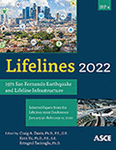Enhancing Chances for Water to Cross the San Andreas Fault in the Elizabeth Tunnel
Publication: Lifelines 2022
ABSTRACT
The designer of the Los Angeles Aqueduct was aware of the location and importance of the San Andreas fault, and that it was crossed in the Elizabeth Tunnel. Fairmont Reservoir, which provided storage at the upstream end of the tunnel, was taken out of service after the 1971 San Fernando earthquake because its design was the same as a dam at the southern terminus of the aqueduct that failed. A new dam was constructed to provide head with piping that included a bulkhead in the tunnel to prevent backflow into the reservoir. The 2008 Great Southern California ShakeOut scenario revealed that all three aqueducts bringing water to Southern California could be damaged in a single earthquake. The Los Angeles Department of Water and Power considered constructible “enhancements” that might allow water to flow through the tunnel after fault displacement. A short section of high density polyethylene (HDPE) pipe placed across the fault zone inside the tunnel was considered because of its excellent performance in the 2010–2011 Christchurch earthquakes. Some unstable locations were indicated in 1907–1911 as-built tunnel construction geology notes, but most of the concrete-lined tunnel had no notes and it has not been tested by nearby earthquakes. Considerations began in 2012 for anchoring an HDPE pipe in the semicircle invert. The existing bulkhead was to be replaced with a removable-door bulkhead to allow construction access from the out-of-service reservoir. Design alternatives were studied; steel ribs were added for structural support across the 146-m-wide zone of most recent faulting; shotcrete overlays were added in very poor rock quality zones identified with a seismic refraction survey inside the tunnel. HDPE pipe was eliminated from the design concept during final design, which was completed in 2020 by Los Angeles Department of Water and Power engineers. Construction was planned to begin in late 2021 and be completed by 2026.
Get full access to this article
View all available purchase options and get full access to this chapter.
REFERENCES
Anon. (1918). “Earthquakes in their relation to the Los Angeles aqueduct: Synopsis of remarks by Wm. Mulholland before a meeting of the Southern Section American Institute of Mining Engineers, Los Angeles, California, January 7, 1918.” Bulletin of the Seismological Society of America 8(1), 13-19.
Barton, N. (2007). Rock Quality, Seismic Velocity, Attenuation and Anisotropy. CRC Press.
Chen, R., and Peterson, M. (2011). “Probabilistic fault displacement hazards for the southern San Andreas Fault using scenarios and empirical slips.” Earthquake Spectra. 27(2), 293-313.
City of Los Angeles. (1916). Complete report on construction of the Los Angeles Aqueduct. Department of Public Service. <https://scvhistory.com/scvhistory/laaqueductreport1916.htm>(Oct. 26, 2020).
Davis, C., and O’Rourke, T. (2011). “ShakeOut scenario: Water system impacts from a Mw 7.8 San Andreas earthquake.” Earthquake Spectra. 27(2), 459-476.
Graves, R., Aagaard, B., Hudnut, K., Star, L., Stewart, J., and Jordan, T. (2008). “Broadband simulations for Mw 7.8 southern San Andreas earthquakes: Ground motion sensitivity to rupture speed.” Geophysical Research Letters, 35(22).
Jones, L., Bernknopf, R., Cox, D., Goltz, J., Hudnut, K., Mileti, D., Perry, S., Ponti, D., Porter, K., Reichle, M., Seligson, H., Shoaf, K., Treiman, J., and Wein, A. (2008). The ShakeOut Scenario. <http://pubs.usgs.gov/of/2008/1150/>(Oct. 26, 2020.
Hart, E. (1994). Fault rupture hazard zones in California: Alquist-Priolo Earthquake Fault Zoning Act with index to earthquake fault zones maps. California Dept. of Conservation, Div. of Mines and Geology, Sacramento.
Hernandez, J. (2011). Preliminary geologic map of the Lake Hughes 7.5' Quadrangle, Los Angeles County, California. Calif. Geol. Surv. Digital Database.
Lang, B. (1999). “Permanent sealing of tunnels to retain tailings or acid rock drainage.” Mine, Water & Environment, 1999 IMWA Congress, Sevilla, Spain, 647-655.
O’Rourke, T., Jeon, S., Toprak, S., Cubrinovski, M., and Jung, J. (2012). “Underground lifeline system performance during the Canterbury earthquake sequence.” Paper presented at 15th World Conference on Earthquake Engineering, Lisboa. http://www.nees.cornell.edu/upload/15WCEE-Invited-Paper-O-Rourke-et-al.pdf.
Rogers, J. D. (2007). “The 1928 St. Francis Dam Failure and the 1995/2005 La Conchita Landslides: The Emergence of Engineering Geology and Its Continuing Role in Protecting Society.” in Guptill, P., Gonzalez, T., eds., Guidebooks for Field Trips, AEG 50thAnn. Mtg, Los Angeles, 79-198. https://scvhistory.com/scvhistory/ro2007asce.htm.
Seed, H., Idriss, I., and Arango, I. (1983). “Evaluation of Liquefaction Potential Using Field Performance Data.” Journal of Geotechnical Engineering. ASCE, 109(3) 458-482.
Sutherland, M., Keaton, J., Heron, C., and Kuganenthira, N. (2014). “Seismic Enhancements for Delivering Water to the City of Los Angeles across the San Andreas Fault in the Elizabeth Tunnel.” Proceedings of the 2014 Geo-Congress. Abu-Farsakh, M., Yu, X., and Hoyos, L. (eds). ASCE Geotechnical Special Publication GSP234. 3779-3788.
Zielke, O., Arrowsmith, J., Grant Ludwig, L., and Akciz, S. O. (2012). “High resolution topography-derived offsets along the 1857 Fort Tejon earthquake rupture trace, San Andreas Fault.” Bull. Seis.Soc.Am, doi: https://doi.org/10.1785/0120110230, 102(3) 1135-1154.
Information & Authors
Information
Published In
History
Published online: Nov 16, 2022
Authors
Metrics & Citations
Metrics
Citations
Download citation
If you have the appropriate software installed, you can download article citation data to the citation manager of your choice. Simply select your manager software from the list below and click Download.
